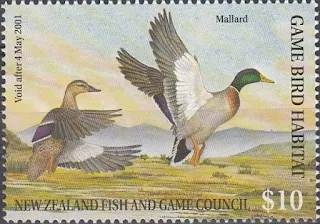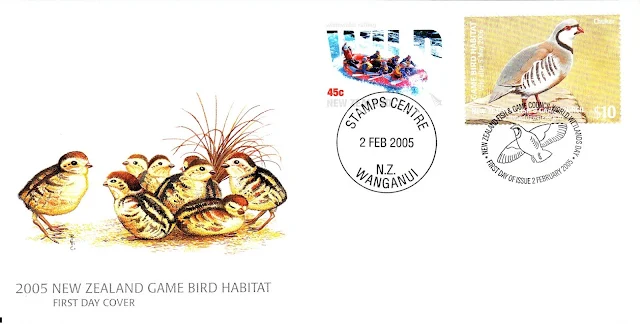 The New Zealand Game Bird Habitat Trust, established under the 1953 Wildlife Act, exists primarily to improve New Zealand game bird habitat, and secondarily to improve the habitat for other wildlife. The key purpose of the Game Bird Habitat Trust Board is to distribute funding for the development and enhancement of wetland habitat for the benefit of game birds and other wetland inhabitants.
The New Zealand Game Bird Habitat Trust, established under the 1953 Wildlife Act, exists primarily to improve New Zealand game bird habitat, and secondarily to improve the habitat for other wildlife. The key purpose of the Game Bird Habitat Trust Board is to distribute funding for the development and enhancement of wetland habitat for the benefit of game birds and other wetland inhabitants.The New Zealand Fish and Game Council commenced issuing $10 license stamps in 1994. The stamp is affixed to the game bird hunter's license thus validating the license for the current year. $2 of the license fee goes towards establishment and protection of Game Bird Habitats. The stamps and related products such as miniature sheets and First Day Covers are also marketed by NZ Post with funding received going back to the Habitat Trust.
This page will cover the stamps and all collector items for the year 2000 through 2009. In many cases, items may be missing but will be added when we find them. Consider this to be an on-going project that will be added to and improved as time goes on.
Game Bird Habitat Page One - 1994 - 1999.
Game Bird Habitat Page Two - 2000 - 2009.
Game Bird Habitat Page Three - 2010 - 2019.
Game Bird Habitat Page Four - 2020 - 2029.
2000 - Game Bird.
2000 - Mallard.
Mallard Ducks are common wild ducks that live in Northern Hemisphere wetlands. In New Zealand, mallards were released to supplement wild duck populations. Because introduced mallards are mating with the native grey duck, the proportion of pure grey ducks remaining is now thought to be only about five per cent.
Mallards feed by "dabbling" and upending, meaning that they tip their bodies into the water, bill first, tail in the air, to forage for food. Their diet is 90% vegetarian, consisting mainly of seeds of grasses, sedges, pondweeds and other aquatic vegetation. Snails, insects and small fish sometimes are taken as well.
2000 Game Bird - Miniature Sheet First Day Cover.
2nd February 2000.
2000 Game Bird - Miniature Sheet.
2001 - Game Bird.
2001 - Ring-Necked Pheasant.
“Common” Pheasants were first introduced into New Zealand from Great Britain as early as 1842 but it was not until over two decades later that they became successfully established. One of the first successes was achieved in Canterbury in 1865, and other importations soon followed. In 1868 the Canterbury Acclimatisation Society bred forty birds and sold them to landowners for £2 a pair. The initial breeding was carried out in aviaries the aim was to establish self-sustaining populations in the wild.
According to Fish & Game New Zealand, the Ring-necked pheasant that is seen in the wild today is a hybrid of three breeds – Blacknecks, Chinese Ringnecks and Mongolian pheasants.
2001 Game Bird - First Day Cover.
2nd February 2001.
(This image will be replaced if we find a better one.)
2001 Game Bird - Miniature Sheet.
2002 - Game Bird.
2002 - Pukeko.
The pukeko is a large, conspicuous rail found throughout New Zealand. The head, breast and throat are deep blue/violet, the back and wings are black, and the under-tail coverts are conspicuously white. The conical bright red bill is connected to a similarly coloured ‘frontal shield’ ornament covering the forehead, the eyes are also red. Females are smaller than males but similarly coloured. Juveniles are similar to adults but duller, with black eyes and black bill and shield that turns red around 3 months of age.
Pukeko are primarily vegetarian, but animal foods make up a small proportion of the diet. Most common foods are the stems, shoots, leaves and seeds of grasses. They also eat garden vegetables and crop plants. Animal foods consist mostly of insects, spiders and earthworms, however, there are rare reports of pukeko taking larger prey such as frogs, lizards, fish and nestling birds.
2002 Game Bird - First Day Cover.
2nd February 2002.
2nd February 2002.
2002 Game Bird - Miniature Sheet First Day Cover.
2nd February 2002.
2002 Game Bird - Miniature Sheet.
2003 - Game Bird.
2003 - Grey Teal.
The grey teal is small, slim, ‘plain-faced’ duck, considerably smaller than a mallard or grey duck. It is mostly grey-brown in colour with pale cheeks, chin and throat. Most occur in areas below 300 m above sea level and they are rare above 900 m. The preferred habitat is shallow freshwater lakes, lagoons and swamps with extensive marginal cover, but at times birds are seen on salt and brackish water.
Grey teal are normally nocturnal feeders but are frequently seen foraging at dawn and dusk. They feed on small aquatic insects, molluscs and the seeds of swamp plants. Food is obtained by filtering the surface water and the mud.
2003 Game Bird - First Day Cover.
2nd February 2003.
2003 Game Bird - Miniature Sheet First Day Cover.
2nd February 2003.
2003 Game Bird - Miniature Sheet.
2004 - Game Bird.
2004 - Paradise Shelduck.
The paradise shelduck Tadorna variegata, also known as putangitangi, is endemic to New Zealand. It is New Zealand's most abundant native duck, widely distributed throughout the country, on open grassland, inland lakes, high altitude streams, and coastal areas. Farmland is a favourite habitat for feeding on grass, clover and weeds, and their seeds, and insects and earthworms. Aquatic vegetation is also part of their diet.
2004 Game Bird - Miniature Sheet.
2005 - Game Bird.
2005 - Chukar.
Chukar are boldly-marked game birds that in New Zealand, are confined to South Island high country. They were introduced from Asia in the 1920s-1930s. Despite more than 80 years of captive breeding and releases by acclimatisation societies, and more recently Fish & Game New Zealand, chukar are not numerous, and are declining in range. Chukar is predominantly vegetarian, foraging for seeds and foliage plus a few invertebrates. Food is obtained by pecking at the ground and foliage, or by scratching in soil.
2005 Game Bird - First Day Cover.
2nd February 2005.
2nd February 2005.
2005 Game Bird - Miniature Sheet First Day Cover.
2nd February 2005.
2005 Game Bird - Miniature Sheet.
2006 - Game Bird.
2006 New Zealand Scaup.
New Zealand scaup are quite unlike any other resident duck species. Dark and squat with a rounded profile, they often occur in large flocks, floating with cork-like buoyancy. Scaup are diving ducks and spend a lot of time underwater, where they can travel considerable distances. Scaup obtains most of their food by diving. Prey items include snails, chironomid larvae and caddisfly larvae. Plant material is probably taken also. The New Zealand scaup population was estimated at 20,000 birds in the 1990s. This may have increased following the range and population expansion reported in Canterbury.
2006 Game Bird - Miniature Sheet First Day Cover.
2nd February 2006.
2006 Game Bird - Miniature Sheet.
2007 - Game Bird.
2007 - Brown Quail.
The brown quail was introduced to Auckland, Wellington, Otago and Southland during 1866-80, but is currently restricted to the northern North Island and its offshore islands. Tiritiri Matangi Island and Shakespear and Tawharanui Regional Parks are the most accessible places in New Zealand where brown quail are reliably found. Brown quail glean from low foliage and forage in leaf litter for seeds, leaves, flowers and invertebrates. Analysis of faecal samples showed a high proportion of invertebrate parts.
2007 Game Bird - First Day Cover.
2nd February 2007.
2007 Game Bird - Miniature Sheet.
2008 - Game Bird.
2008 - Red-Legged Partridge.
The natural range of the red-legged partridge is western Europe, Corsica and the Canary Islands. It breeds naturally in southwestern Europe, in France and Iberia and has become naturalised in southern England. It has been introduced into many places worldwide, including New Zealand. New Zealand introductions in the late 19th century met with little success but attempts in the 1980s have met with mixed success. The species is now common on many game bird preserves. Their preferred habitat is dry lowlands, farmland and rolling hill country with scrubby gullies which supply dense cover.
2008 Game Bird - First Day Cover.
2nd February 2008.
2nd February 2008.
2008 Game Bird - Miniature Sheet First Day Cover.
2nd February 2008.
2008 Game Bird - Miniature Sheet.
2009 - Game Bird.
2009 - NZ Shoveler.
The New Zealand shoveler Anas rhynchotis variegata, also known as kuruwhengi, is a subspecies only common to New Zealand. It is found in tidal harbours, lowland swamps and lake edges throughout the country, except Stewart Island where it is uncommon. It uses its wide flat bill for sieving food from the water and mud. Their food is mainly freshwater invertebrates and the seeds of aquatic plants, however, worms and insects are sometimes eaten in flooded pasture.
2009 Game Bird - First Day Cover.
2nd February 2009.
2009 Game Bird - Miniature Sheet First Day Cover.
2nd February 2009.
2009 Game Bird - Miniature Sheet.
2009 Game Bird - First Day Cover.
2nd February 2009.
2009 Game Bird - Miniature Sheet First Day Cover.
2nd February 2009.
2009 Game Bird - Miniature Sheet.
Information & images for this post came from.



































We appreciate your engagement with our content. To ensure a respectful and constructive community, please take note of the following:
- No Spam, Please: We do not tolerate spammy or promotional comments. Any such comments will be promptly removed.
- Moderation in Place: All comments are moderated to maintain a positive and inclusive environment. Please be patient, as it may take a little time for your comment to appear.
- Sign In with Google: To comment, please sign in using your Google account. This helps us maintain the integrity of our community and allows for better interaction.